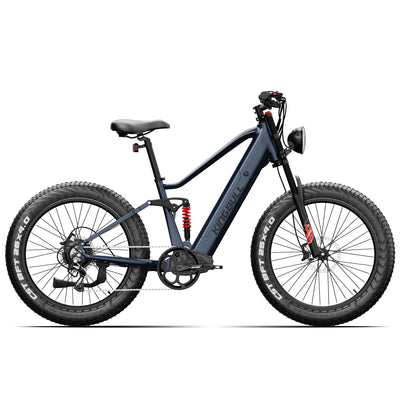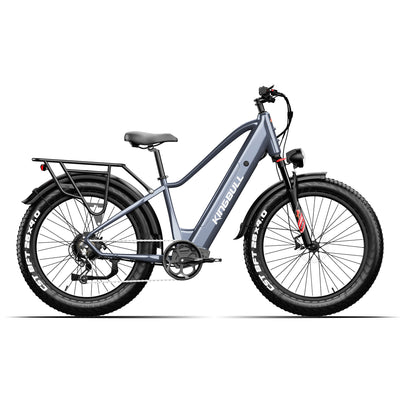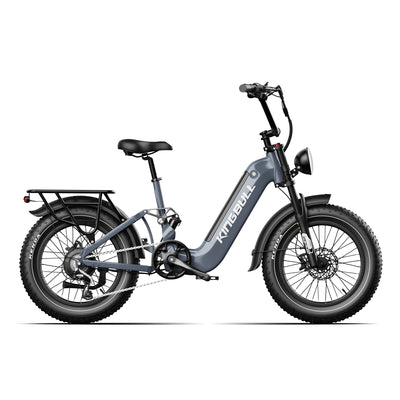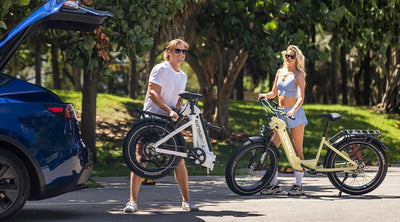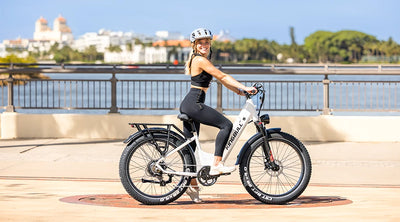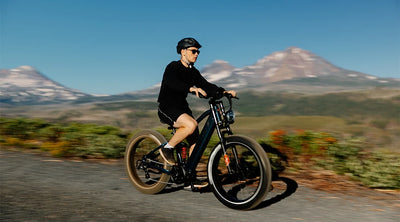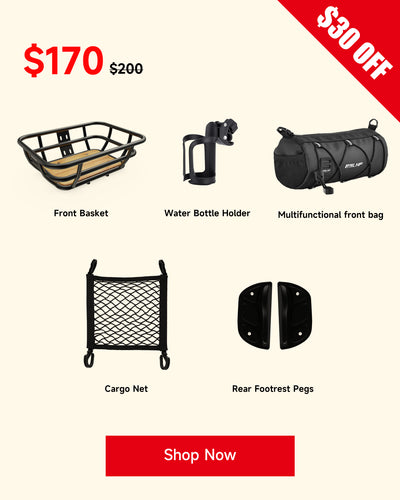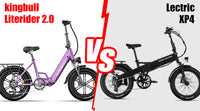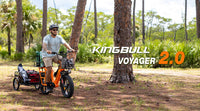Explore News
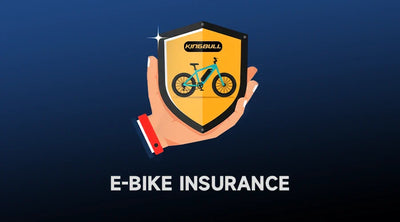
Tips & Cycling Knowledge
Do You Need Insurance for Your E-Bike in the U.S.? A Complete Guide
Electric bikes (e-bikes) are booming in popularity across the U.S. — from daily commuters in big cities to weekend riders exploring trails. But while most people think about range, speed, or motor power when buying an e-bike, one important question often gets overlooked: Do I need insurance for my e-bike?
The answer depends on where you live, how you ride, and the type of e-bike you own. Let’s break it down.
Why Consider Insurance for Your E-Bike?
Theft is common. E-bikes are valuable and attractive to thieves. A stolen e-bike can mean a big financial loss.
Accidents happen. If you accidentally collide with a pedestrian or vehicle, you could face liability costs.
Repairs can be costly. Batteries, motors, and frames aren’t cheap to replace if damaged.
Peace of mind. Insurance can make riding stress-free, especially for daily commuters.
Types of Insurance That May Cover E-Bikes
1. Homeowners or Renters Insurance
Often covers theft of personal property, including e-bikes, if stolen from your home or garage.
Usually does not cover accidents, liability, or damage while riding.
Important: Some policies exclude e-bikes with motors. Always confirm with your insurance provider.
2. Specialized E-Bike Insurance
Providers like Velosurance, Spoke Insurance, or Markel Insurance offer dedicated e-bike coverage. These typically include:
Theft (at home or on the road)
Collision or crash damage
Liability if you injure someone or damage property
Medical payments for injuries
Roadside assistance in some cases
👉 Best for frequent riders, commuters, or anyone with a high-value e-bike.
3. Personal Liability or Umbrella Policies
Protects you if you cause injury or damage while riding.
Often used to supplement other coverage.
4. Health Insurance
Covers your own medical costs if you get hurt in an accident.
Does not cover bike repairs or damage to others.
5. Motorcycle/Moped Insurance (in Some States)
If your e-bike is faster or more powerful (class 3 or modified), your state might classify it as a moped.
In this case, you may be legally required to carry insurance similar to motorcycle coverage.
Which Insurance Is Right for You?
Casual riders with low-speed e-bikes (Class 1 or 2):Homeowners/renters + health insurance may be enough.
Daily commuters or higher-value e-bike owners:Specialized e-bike insurance is worth it.
High-speed e-bike riders (Class 3, 28 mph):Check your state laws — you may need motorcycle-style coverage.
Final Tips Before You Ride
✅ Always lock your e-bike with a high-quality lock — insurance won’t stop theft but can reduce the financial hit.✅ Keep receipts, photos, and serial numbers — this makes claims easier.✅ Check your state’s e-bike classification laws before choosing coverage.
Bottom Line
While not legally required in most states, insurance for your e-bike is a smart investment if you ride frequently, commute daily, or own a higher-value model. The right policy can protect you from theft, costly repairs, and liability — giving you confidence every time you hit the road.
Read more
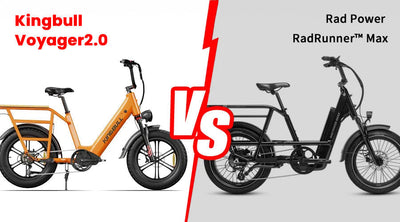
Ebike Comparison
Cargo eBike Showdown: Kingbull Voyager 2.0 vs Rad Power RadRunner Max
The Best Cargo E-Bike Debate: When Every Pound Matters
Picture this: You're heading out for a family adventure, groceries in tow, maybe a passenger on the back, and your regular bike just won't cut it. Enter the world of cargo e-bike – where power meets practicality, and every specification can make or break your ride.
Today's battle features two heavyweight contenders in the cargo e-bike arena: the budget-friendly Kingbull Voyager 2.0 at $1,399 and the premium Rad Power RadRunner™ Max at $2,299. Let's dive deep into what really matters when the rubber meets the road – and the cargo meets the rack.
📊 The Cargo Capacity Face-Off
Payload Capacity: Who Carries More?
Kingbull Voyager 2.0: 450 lbs maximum load
Rad Power RadRunner™ Max: 420 lbs maximum load
Winner: Voyager 2.0 (+30 lbs advantage)
Real-world impact: That extra 30 lbs means room for an additional child, more groceries, or heavier cargo without worrying about weight limits.
Motor Power: Moving Heavy Loads
Kingbull Voyager 2.0: 750W Bafang Motor
Rad Power RadRunner™ Max: 750W Motor (Brand Unknown)
Winner: Slight edge to Voyager 2.0 for brand reputation
Analysis: Equal power output, but Bafang motors are industry-proven for cargo applications and heavy-duty use.
Battery Capacity: Powering Through Heavy Loads
Kingbull Voyager 2.0: 720Wh (15Ah) Samsung cells
Rad Power RadRunner™ Max: 672Wh (14Ah)
Winner: Voyager 2.0 (+48Wh advantage)
Analysis: Higher capacity is crucial for cargo bikes – more weight requires more power, and Samsung cells offer superior longevity.
It's worth noting that the Kingbull Voyager 2.0 also comes in a dual-battery version ($1,799) with 720Wh*2=1440Wh capacity, perfect for users who need extended range for heavy-duty applications.
Range: How Far Can You Haul?
Kingbull Voyager 2.0: 60 miles
Rad Power RadRunner™ Max: 60 miles
Winner: Tie
Analysis: Despite Voyager 2.0's larger battery, both achieve similar range, indicating RadRunner Max's efficient power management.
For users requiring maximum range, the Voyager 2.0 dual-battery version delivers up to 100 miles of riding distance for an additional $400 investment.
Gearing: Tackling Hills with Cargo
Kingbull Voyager 2.0: Shimano 7-speed
Rad Power RadRunner™ Max: Shimano 8-speed
Winner: RadRunner Max (+1 gear advantage)
Analysis: Extra gear provides better hill-climbing options when loaded, though 7-speed is adequate for most terrain.
Safety Features: Protecting Your Precious Cargo
Kingbull Voyager 2.0: No radar system
Rad Power RadRunner™ Max: Rear radar detection
Winner: RadRunner Max
Analysis: Radar detection is valuable for cargo bikes since they're often wider and carry precious cargo, making awareness of approaching vehicles crucial.
Price Comparison
Kingbull Voyager 2.0: $1,399
Rad Power RadRunner™ Max: $2,299
Difference: $900 savings with Voyager 2.0 (39.1% less expensive)
Analysis: Significant price advantage makes the Voyager 2.0 the best value cargo e-bike, making this affordable cargo bike accessible to more families.
🏆 The Cargo Bike Scorecard
Category
Voyager 2.0
RadRunner Max
Price Value
$1,399
$2,299
Payload Capacity
450lb
420lb
Battery Capacity
720Wh Samsung
672Wh
Motor Quality
750W BAFANG
750W
Range
60 mile
60 mile
Tires
20" x 4"
20" x 3.5"
Speed
Up to 28mph
Up to 28mph
Brakes
ZOOM Hydraulic
Gemma Hydraulic
Gearing
7 Speed
8 Speed
Radar
No
Radar Detection
The Final Verdict: Choose Your Cargo Champion
Both the Kingbull Voyager 2.0 and Rad Power RadRunner™ Max offer impressive capabilities for cargo hauling, but the best choice depends on your specific priorities. If you value maximum payload capacity, superior battery performance, and exceptional value, the Voyager 2.0 is the clear winner. However, if you prioritize advanced safety features and established brand support, the RadRunner™ Max might justify its premium price.
Don't miss out—Discover the best value cargo e-bike Kingbull Voyager 2.0 lineup: starting at $1,399 for the standard model, or $1,799 for extended-range dual-battery performance – premium cargo e-bike capabilities without the premium price!
Read more
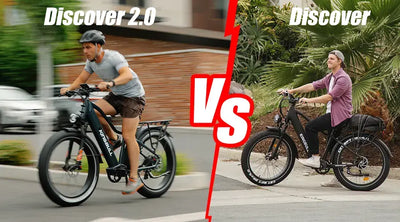
Ebike Comparison
From Solid to Spectacular: Unpacking the Upgrades from the Kingbull Discover 1.0 to the 2.0
If you've been following the e-bike scene, you know the Kingbull Discover series has built a reputation for being a dependable and powerful ride. The original Discover 1.0 was a fantastic workhorse, but with the new 2.0 model, Kingbull isn't just making a few tweaks—they've engineered a comprehensive upgrade that redefines the riding experience.
Let's dive into the details and see what's changed, and more importantly, why it matters for your next ride.
The Big Picture: What's New?
Think of the Discover 1.0 as your reliable, do-it-all companion. The 2.0, however, is its more refined, high-performance sibling. The upgrades aren't just about bigger numbers; they're about giving you more control, more comfort, and more confidence on the road.
Key Component Enhancements at a Glance
Component
Discover
Discover 2.0
Key Enhancements
Motor
750W Sustained
Bafang 750W Hub Motor
Integration of an industry-leading Bafang motor for a known level of performance and reliability.
Fork
Hydraulic Fork, 80mm Travel
KINGBULL GS-D26 Spring Fork, Lockout & Preload
Addition of lockout and adjustable preload features for greater adaptability across different terrains.
Brakes
Hydraulic Brakes with Motor Cutoff
ZOOM HB-875E Hydraulic Brakes with Motor Cutoff
Upgraded to a reputable ZOOM brand brake system, known for superior quality and durability.
Sensor
Cadence Sensor
TRÖG-1B Torque Sensor
Transition to a torque sensor for a more intuitive and natural pedaling experience.
Display
Color LCD Display with USB Charging
Color Backlit Horizontal Display
Redesigned display layout for better visibility and more convenient access to riding data.
Battery
48V, 17.5Ah Lithium-ion
SAMSUNG 48V/720Wh Lithium Battery
Use of a reputable Samsung battery, ensuring quality and peace of mind.
Frame
6061 Aluminum with Internal Battery
All Aluminum, Tapered Head Tube, Internal Routing
Improved frame rigidity via a tapered head tube, and a sleeker look with internal cable routing and a color-matched, more discreet battery.
Saddle
Standard
Eco-leather, Aluminum Rails
Upgrade to an eco-leather saddle for enhanced rider comfort.
Why These Upgrades Make a Real Difference
1.The Bafang Motor: A Name You Can Trust
The 1.0’s motor was no slouch, but the 2.0’s new Bafang motor is a game-changer. Bafang is the gold standard in the e-bike world. This isn’t just about power; it’s about a motor that’s been rigorously tested and is known for its incredible reliability and smooth performance. It’s like trading in a good engine for a great one that you know will last.
2. The Fork: Ride Your Way
The hydraulic fork on the 1.0 was solid, providing a good cushion on bumpy trails. But the 2.0’s new fork with its lockout feature is a true upgrade. Hitting a rough patch? Keep it unlocked for a smooth ride. Switching to a paved road or tackling a steep hill? Lock it out to prevent "fork bob" and transfer all your pedaling power directly into speed. This versatility is what sets the 2.0 apart.
3. The Brakes: Stopping with Confidence
Both bikes have hydraulic brakes with a motor cutoff—a must-have safety feature. But the 2.0 makes a crucial switch to ZOOM hydraulic brakes. This isn't just a different part number; it’s a quality upgrade. ZOOM is a trusted brand, and their components are known for their precision, durability, and consistent stopping power. It’s the kind of subtle change that makes a huge difference in your long-term confidence and safety.
4. The Sensor: An Extension of Yourself
The 1.0's cadence sensor was simple: as long as you were pedaling, it gave you a set amount of assist. The 2.0’s new torque sensor is much smarter. It measures how hard you're actually pedaling and adjusts the motor’s output accordingly. The result? A ride that feels incredibly natural, almost as if the bike is reading your mind. It’s less like a machine helping you and more like your own power has been doubled.
5. The Display: Data at a Glance
The 1.0’s display was functional. The 2.0's new horizontal, backlit display is a significant usability upgrade. Its new layout and bright backlighting make it far easier to read your speed, battery life, and other vital stats without squinting or straining, even in direct sunlight. It’s a small detail that improves your overall riding experience.
6. The Frame & Design: The Perfect Marriage of Form and Function
The 1.0’s frame was robust, but the 2.0 introduces a tapered head tube that brings a new level of stiffness and stability to the front end. This means more precise steering and a more secure feel, especially when cornering. And let’s not forget the aesthetics: the color-matched, integrated battery makes the bike look incredibly sleek and modern. It’s a seamless design that says "high-end" without a high-end price tag.
The Verdict
While the Kingbull Discover 1.0 remains a strong and reliable bike, the 2.0 is a testament to thoughtful, user-focused engineering. Every major upgrade, from the motor to the frame, is designed to give you a more intuitive, safer, and ultimately more enjoyable ride. If you're looking for an e-bike that feels less like a tool and more like an extension of your own two feet, the Discover 2.0 is the clear choice.
Read more
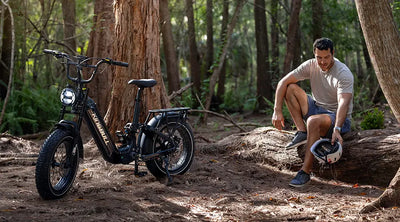
Tips & Cycling Knowledge
E-Bike Camping Guide: Your Green Outdoor Adventure Awaits
Summer breeze gently blowing, sunshine just right – perfect weather for a spontaneous camping trip! If you're considering embarking on a green outdoor adventure with your electric bike, this guide is exactly what you need.
Packing camping gear
E-Bike Equipment: Spare batteries, charger, basic repair tools, panniers
Camping Gear: Lightweight tent, sleeping bag, portable stove, lighting
E-bike camping requires an even smarter packing strategy. Every extra item adds difficulty to your ride and drains more battery power. Especially for overnight camping trips, traveling light is essential.
Route Planning Essentials
Range Calculation
Plan daily riding distances considering:
Battery capacity and actual range
Terrain elevation and wind effects
Load impact on range (typically reduces 20-30%)
Charging point distribution
Campsite Selection
Find campsites with electrical outlets
Consider sunlight conditions for solar charging
Ensure safe storage for your e-bike
Safety Considerations
Riding Safety
Wear helmet and reflective gear
Install front and rear lights for visibility
Carry first aid kit and emergency contacts
Inform others of your travel plans
Equipment Security
Use high-quality locks, park bike near tent at night
Waterproof battery protection
Regularly check bolt tightness
Charging Strategy
Multiple Charging Options
Campsite Charging: Choose official campsites with power outlets
Solar Charging: Carry portable solar panels
Power Banks: Large capacity power banks for emergency backup
En-route Charging: Coffee shops, gas stations, and public venues
Eco-Friendly Camping
Follow "Leave No Trace" principles
Use eco-friendly toiletries
Respect wildlife and vegetation
Choose sustainable camping gear
Practical Tips
Test ride with gear before departure
Prepare detailed emergency contact list
Learn basic bike maintenance skills
Monitor weather forecasts and prepare accordingly
Join e-bike camping communities to share experience
E-bike camping offers a revolutionary outdoor experience, allowing us to explore nature in a more eco-friendly and healthy way. With proper preparation and planning, you'll enjoy an unforgettable green adventure!
At Kingbull Bikes, we're passionate about helping you discover the freedom of electric cycling. Our reliable e-bikes are designed to handle both urban commutes and outdoor adventures, making them perfect companions for your camping journeys. Ready to start your green adventure? Explore our collection and find the perfect e-bike for your next outdoor expedition!
Read more
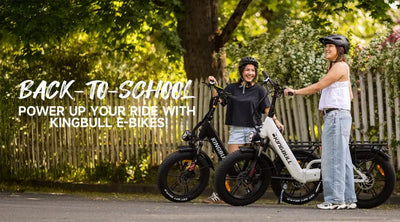
Purchase Guide
Balancing Fun and Safety: A Guide to E-Biking for Students
The new school year is just around the corner, and there’s a trend sweeping high schools and college campuses nationwide: e-bikes! Chances are you’ve already seen them all over TikTok and Instagram—students effortlessly cruising past traffic, arriving to class on time, and looking good while doing it.
It’s clear: the e-bike has become the go-to ride for this generation, offering the perfect mix of freedom, convenience, and style.
Why Students Are Making the Switch
It’s not just about looking cool (though that’s definitely a perk 😉). E-bikes deliver real, everyday benefits that make student life easier:
✅ Beat the Traffic – Glide past the morning rush and take shortcuts cars can’t. With an e-bike, you’ll never stress about being late again.
✅ Save Time & Money – No more gas prices, parking fees, or long waits for the bus. E-bikes are budget-friendly, giving you extra cash for the important stuff (like coffee, snacks, or that one professor’s “must-have” textbook).
✅ Stress-Free Commute – A quick ride gives you fresh air and just enough movement to boost your mood. It’s the perfect way to recharge before a big exam or wind down after class.
Ride Smart, Ride Safe: Your E-Bike Safety Checklist 🛡️
E-bikes are fun and powerful—but safety always comes first. Here’s how to stay smart on the road:
👩🚀 Helmet Hero – Non-negotiable! A fitted helmet is your best defense.
🚦 Know the Rules – Remember: e-bikes are vehicles. Follow traffic laws, signal turns, and always stop at red lights and stop signs.
🔧 Check Your Ride – Take 30 seconds before each ride to check tire pressure, brakes, and lights. A little maintenance = big peace of mind.
👀 Stay Aware – Keep your eyes open for pedestrians, cyclists, and cars—especially during busy campus hours.
Gear Up for the New Semester 🎒
At Kingbull, we’re passionate about making safe, reliable, and fun e-bikes accessible to every student. Our models are built with high-quality components—from responsive brakes to long-lasting batteries—so you can ride to and from campus with total confidence.
🎉 Back-to-School Sale: Save up to $800!Even better: pair it with our Buy 2, Get $200 OFF deal and enjoy double the savings. 🚴♂️
Stock is limited, so don’t wait—this is your chance to kick off the semester with the perfect ride.
Are You an E-Bike Expert? 🤓
Test your knowledge with our quick 5-question quiz [Click here to play!].
And don’t forget to share your back-to-school e-bike adventures in our Facebook community—let’s inspire each other and grow a network of smart, safe riders!
Read more
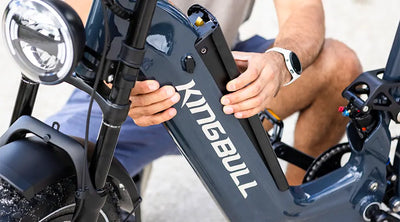
Maintenance
Complete E-Bike Maintenance Guide: Keep Your Electric Bike Like New
Why E-Bike Maintenance Matters
Electric bikes are sophisticated machines that require proper care to ensure optimal performance, safety, and longevity. Regular maintenance not only extends your e-bike's lifespan but also keeps you safe on the road.
Battery Care
Charging Best Practices
Always use the original charger provided by the manufacturer
Avoid overcharging - unplug when fully charged
Charge when battery reaches 50-70% capacity
Avoid charging in extreme temperatures (below 32°F or above 104°F)
If storing long-term, charge at least once per month
Battery Storage
Store in a cool, dry place away from direct sunlight
Maintain 50% charge level for long-term storage
Remove battery if storing bike for extended periods
Check battery connections regularly for corrosion
Mechanical Components
Chain Maintenance
Clean chain every 100-200 miles or after wet rides
Use a dedicated chain cleaner and degreaser
Apply chain lubricant after cleaning
Check chain tension and adjust as needed
Replace chain when stretched beyond manufacturer specs
Brake System
Inspect brake pads for wear regularly
Adjust brake cable tension as needed
Keep brake rotors clean and free from oil
Test brake function before each ride
Replace brake pads when worn to minimum thickness
Tire Care
Check tire pressure weekly (refer to sidewall for PSI)
Inspect for cuts, punctures, or excessive wear
Remove debris stuck in tread
Replace tires when tread depth is insufficient
Rotate tires if wear pattern is uneven
Electrical System
Controller and Display
Keep electrical components dry and clean
Check all connections for looseness or corrosion
Clean display screen with soft, dry cloth
Address error codes immediately
Protect from water during cleaning
Motor Maintenance
Keep motor housing clean and dry
Avoid riding through deep water
Check motor mounting bolts for tightness
Listen for unusual noises during operation
Have motor serviced if overheating occurs
Daily Riding Tips
Good Riding Habits
Start pedaling before engaging motor assistance
Use appropriate assist levels for terrain
Avoid sudden acceleration and hard braking
Don't exceed maximum weight capacity
Clean bike after riding in wet conditions
Storage Recommendations
Store in a covered, secure location
Use a bike cover for outdoor storage
Avoid leaving in direct sunlight for extended periods
Rotate bike position occasionally to prevent tire flat spots
Troubleshooting Common Issues
Reduced Range
Check battery health and age
Verify proper tire pressure
Assess riding conditions and habits
Consider battery replacement if significantly degraded
Unusual Noises
Check chain lubrication and alignment
Inspect brake pad position
Examine wheel bearings
Listen to motor operation
Electrical Problems
Check all connections
Verify battery charge and condition
Reset system if applicable
Consult manual for error codes
Professional Service: For complex issues or if you're uncomfortable performing maintenance, visit a qualified e-bike technician. At Kingbull Bikes, we offer comprehensive e-bike maintenance and repair services to keep your ride in perfect condition!
Read more




